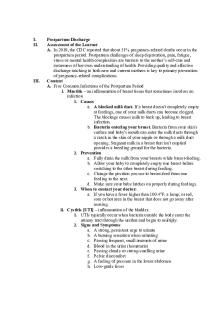Diabetic Teaching Plan 1 PDF

| Title | Diabetic Teaching Plan 1 |
|---|---|
| Author | Amy Ford |
| Course | Health-Illness Concepts Across the Lifespan I |
| Institution | Florida State College at Jacksonville |
| Pages | 2 |
| File Size | 36.6 KB |
| File Type | |
| Total Downloads | 48 |
| Total Views | 185 |
Summary
diabetic patient teaching plan...
Description
Kelly McGonigle Jelena Losic Kathleen Laney June 11, 2020 Diabetic Teaching Plan: Nutrition 1. Reviewing why nutrition is important in stabilizing and maintaining an acceptable blood glucose level. a. Blood glucose levels depend on the type and amount of foods eaten; as well as when the food is eaten throughout the day. 2. Discussion of the relationship and correlation of carbohydrates and blood glucose levels. a. Participant should know how many carbohydrates they should consume within a day. Also need to understand why carbohydrates should be given if experiencing hypoglycemia. 3. Identification of food sources rich in carbohydrates, proteins, and fats. a. Determining which foods when shopping will help the participant develop a health meal plan. 4. Conceptualize a healthy portion size and emphasize a variety of foods during each meal; which should include vegetables, fruits, whole grains, dairy, and lean meats. 5. Understanding the impact of delaying or omitting a meal during the day; also consuming a healthy snack if a meal is missed. a. Understanding the importance of food as a fuel to help complete day-to-day activities. 6. Choosing a healthy meal while eating fast food or dining out at a restaurant. a. Balance is important when picking out meals. Omitting extra sauces and asking for the proteins to be grilled or baked can eliminate empty calories.
Diabetic Teaching Plan: Prevention of Complications/Infection 1. Discuss the signs and symptoms of hypoglycemia and hyperglycemia. a. Both of the situations are potentially dangerous. Client should be able to define appropriate actions to take if experiencing hypoglycemia and hyperglycemia. 2. Discussion of why proper foot care is important and how to properly take care of feet. a. Feet should be kept clean and moist, wear properly fitting shoes and clean socks, examine feet every day for evidence of skin breakdown, sores, or ulcers. b. At every doctor’s visit, shoes and socks should be taken off and assess for signs of nerve-damage. 3. Patients can reduce the risk of developing complications of diabetes by maintaining good blood sugar control. 4. Discuss that people with diabetes are more likely to have problems with their teeth and gums and that, will all infections, dental infections can make blood glucose go up.
Kelly McGonigle Jelena Losic Kathleen Laney June 11, 2020 a. Brush teeth at least twice a day, use a soft toothbrush and use toothpaste with fluoride, floss every day.
Diabetic Teaching Plan: Medication Administration 1. Discuss the importance of taking prescribed medication daily. a. Missing doses of medication will cause your blood sugar to increase. Medicine does not cure diabetes it helps to control it. 2. Blood glucose levels can affect a variety of factors, different medications will be prescribed for individuals and medications can be changed over time. a. Oral pills, insulin pens, inhalers, and combination medications can be prescribed depending on the patient and their treatment needed. b. Patients will understand the function of each of their prescribed medications and how to use them properly. 3. Discuss the side effects of diabetic medication and report any unexpected side effects to your provider. a. N/V, bloating, gas, diarrhea are common side effects of diabetes meds. b. If any medication taken gives the patient a rash it should be discontinued immediately and the provider should be contacted. c. More severe side effects include hypoglycemia, weight gain, and very rarely inflammation of the liver. 4. Patients will understand the function of insulin and why it is used to manage diabetes. a. Patients will be able to understand the use of insulin and demonstrate the injection themselves....
Similar Free PDFs

Diabetic Teaching Plan 1
- 2 Pages

HEALTH TEACHING PLAN SAMPLE
- 3 Pages

Discharge Teaching Plan Solution
- 6 Pages

Teaching Speaking Lesson Plan
- 7 Pages

30146683-Teaching-Plan
- 4 Pages

MSll Teaching Plan Lovenox
- 9 Pages

Patient teaching plan
- 6 Pages

BLHW 1442 Teaching Plan
- 6 Pages

Diabetic Ketoacidosis
- 3 Pages

Diabetic Foot
- 1 Pages

Lesson ON PLAN Teaching Models
- 3 Pages

NFDN Teaching Plan Assignment 2
- 9 Pages
Popular Institutions
- Tinajero National High School - Annex
- Politeknik Caltex Riau
- Yokohama City University
- SGT University
- University of Al-Qadisiyah
- Divine Word College of Vigan
- Techniek College Rotterdam
- Universidade de Santiago
- Universiti Teknologi MARA Cawangan Johor Kampus Pasir Gudang
- Poltekkes Kemenkes Yogyakarta
- Baguio City National High School
- Colegio san marcos
- preparatoria uno
- Centro de Bachillerato Tecnológico Industrial y de Servicios No. 107
- Dalian Maritime University
- Quang Trung Secondary School
- Colegio Tecnológico en Informática
- Corporación Regional de Educación Superior
- Grupo CEDVA
- Dar Al Uloom University
- Centro de Estudios Preuniversitarios de la Universidad Nacional de Ingeniería
- 上智大学
- Aakash International School, Nuna Majara
- San Felipe Neri Catholic School
- Kang Chiao International School - New Taipei City
- Misamis Occidental National High School
- Institución Educativa Escuela Normal Juan Ladrilleros
- Kolehiyo ng Pantukan
- Batanes State College
- Instituto Continental
- Sekolah Menengah Kejuruan Kesehatan Kaltara (Tarakan)
- Colegio de La Inmaculada Concepcion - Cebu



